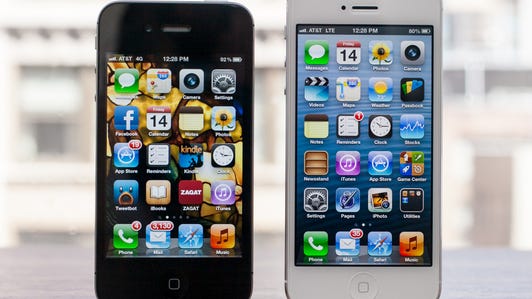Though its thinner profile and longer screen are two of the iPhone 5’s top draws, I’m more interested in what’s inside Apple’s newest handset. Yes, after a long wait, the iPhone 5 finally adds support for 4G LTE data networks. Of course, I have to point out that a galaxy of Android phones (get it!) have long offered the feature, but that doesn’t mean I’m not grateful that at long last the iPhone has caught up.
Editors’ note: This article was originally posted September 22, 2012. We will continue to update it as we record new test results.
Hands-on with the sharp, slim iPhone 5 (pictures)






Early reviewers of the iPhone 5 have already praised the big jump in data speeds from the iPhone 4S. Indeed, CNET’s Scott Stein called the new data speeds “stunningly fast” in his iPhone 5 review. In his testing, AT&T’s LTE network was even faster than his home Wi-Fi.
Related stories
- CNET’s iPhone 5 review
- Apple’s iPhone 5: Everything you need to know (FAQ)
- Choosing an iPhone carrier
- So, what’s new? Comparing the iPhone 4S and iPhone 5
- iPhone 5 vs. Galaxy S3 vs. Lumia 920: By the numbers
Yet, you don’t get the full story of LTE until you compare the iPhone 5 with its immediate predecessor, the iPhone 4S. Remember, that device topped out at 3G on Verizon and Sprint, and 3.5G on AT&T (even if AT&T tried to tell us differently). The speed boost is striking, both in CNET’s anecdotal use and in the tests that we conducted. And to make things interesting, I threw in the Samsung Galaxy S3, which also runs on LTE. Now you can see for yourself just how much faster the LTE phones are.
Before you get to the results, I’ve got a few words about how we conducted the tests. For each phone — as a reminder, that’s the iPhone 5, the iPhone 4S, and the Galaxy S3 — we conducted multiple tests using Ookla’s SpeedTest.net (available free from the iTunes App Store and Google Play). Because our review devices currently are divided between the two CNET offices, we tested the Verizon phones in San Francisco and the AT&T handsets in New York. As soon as we can, though, we’ll trade each batch of phones between us so that all handsets are tested on both coasts. In each location, we used the app to ping the same server and record the download and upload speeds in megabits per second.
This report is a work in progress so we will keep adding more results when they come in and update our evaluations. At the moment, comparing Sprint’s LTE results is trickier since Sprint’s network covers only 19 cities. But once it reaches New York or San Francisco we’ll test the same phones and add the data here.
Verizon Wireless (San Francisco)
table.geekbox th{background-color:#72C9F4;text-align:left;font-weight:bold;}
table{width:600px;}
table.geekbox tr.even{background-color:#CCCCCC;}
.ratingGood{color:#093;} .ratingAverage{color:#666;} .ratingBad{color:#C00;}
| iPhone 5 (LTE) | Galaxy S3 (LTE) | iPhone 4S (EV-DO) | |
|---|---|---|---|
| Test 1 download | 11.92Mbps | 8.77Mbps | 1.02Mbps |
| Test 1 upload | 10.87 | 13.93 | 1 |
| Test 2 download | 7.17 | 10.58 | 1.76 |
| Test 2 upload | 2.88 | 9.36 | 0.96 |
| Test 3 download | 10.05 | 7.3 | 1.78 |
| Test 3 upload | 8.58 | 15.7 | 0.87 |
| Test 4 download | 10.48 | 9.95 | 1.96 |
| Test 4 upload | 7.59 | 14.35 | 0.84 |
| Test 5 download | 9.27 | 7.75 | 2.03 |
| Test 5 upload | 7.44 | 14.39 | 0.88 |
| Average download | 9.78 | 8.87 | 1.71 |
| Average upload | 7.47 | 13.55 | 0.91 |
AT&T (New York)
table.geekbox th{background-color:#72C9F4;text-align:left;font-weight:bold;}
table{width:600px;}
table.geekbox tr.even{background-color:#CCCCCC;}
.ratingGood{color:#093;} .ratingAverage{color:#666;} .ratingBad{color:#C00;}
| iPhone 5 (LTE) | Galaxy S3 (LTE) | iPhone 4S (HSPA) | |
|---|---|---|---|
| Test 1 download | 23.6Mbps | 14.79Mbps | 8.18Mbps |
| Test 1 upload | 10.17 | 7.83 | 1.98 |
| Test 2 download | 20.37 | 19.15 | 6.48 |
| Test 2 upload | 9.55 | 8.45 | 1.92 |
| Test 3 download | 16.69 | 21.08 | 6.5 |
| Test 3 upload | 7.55 | 9.46 | 1.95 |
| Test 4 download | 23.02 | 20.91 | 5.66 |
| Test 4 upload | 7.97 | 10.47 | 1.82 |
| Test 5 download | 18.54 | 20.75 | 7.03 |
| Test 5 upload | 11.73 | 9.39 | 0.61 |
| Average download | 20.44 | 19.34 | 6.77 |
| Average upload | 9.39 | 9.12 | 1.66 |
I know it’s not earth-shattering news, but both the iPhone 5 and the Galaxy S3 smoked the iPhone 4S all around. But even the LTE handsets weren’t in line. On Big Red, the iPhone 5 delivered superior download speeds while the Galaxy S3 enjoyed almost double the upload speeds. On AT&T, the two devices were almost evenly matched. And on the whole, AT&T’s network outperformed Verizon’s.
Keep in mind that your results may vary depending on your location, the strength of a carrier’s network at a given the time, and the number of people using it around you. Carrier network performance changes constantly so there’s no way to guarantee that you’ll get the same results as we found.
CNET Senior Editor Brian Bennett contributed to this report.


Now playing:
Watch this:
iPhone 5: Hands-on at CNET
6:04



